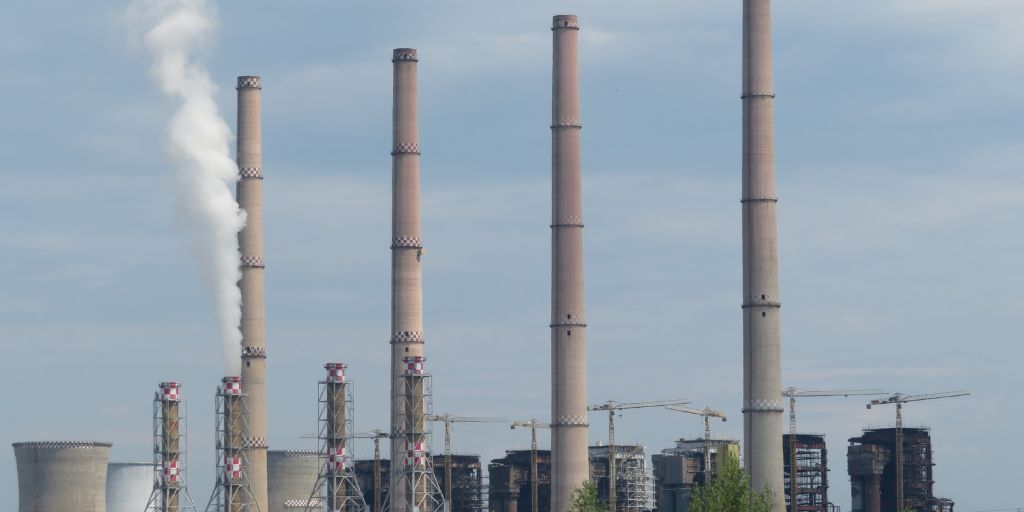The small town of Turceni in southwest Romania has long been a lignite stronghold. But its enormous coal power plant is gradually being closed. A team from Bankwatch recently visited and spoke to the deputy mayor about the town’s efforts to ensure a just transition.
Pippa Gallop, Southeast Europe Energy Policy Officer | 8 August 2024

Since the late 1970s, the town of Turceni has been home to a massive lignite-fired power plant. Its seven 330-megawatt (MW) units were completed between 1978 and 1987, making it the largest power station in Romania.
The plant has brought both prosperity and pollution. In December 2013 it also brought tragedy: damage to the ash landfill dam caused a metre-thick layer of ash sludge to flood 15 hectares of agricultural land and 10 households in the nearby Submaidane settlement. To this day wells remain unusable for drinking.
Unit 6 retired in 2006, and the other units have been closing one by one since 2019. Only unit 5 is now operating regularly, and only until 2025, when it will be put into cold reserve.
A 475 MW combined-cycle gas turbine plant is planned to replace the coal plant at Turceni, supposedly by 2026. Scandalously, funding from the EU Modernisation Fund has been approved for the project, despite it locking Romania into increased fossil gas use.
And while it might sound big, a new gas plant will not help to retain many jobs: it will be highly automatized.
More positively, a 112 MW photovoltaic plant is also planned on the ash dump, also to be funded by the Modernisation Fund. This will also bring very limited employment opportunities, but represents an excellent use of otherwise dead space.
A hive of activity
Turceni has no alternative but to pursue new economic directions, and its authorities are fully aware of this. In late July, we visited deputy mayor Lucian Margineanu to hear more about the town’s efforts so far.
Despite Turceni’s small size – it has around 7000 people – the local authorities are making substantial efforts both to attract new businesses to the area and take advantage of existing funding opportunities to advance the local energy transition.
They have held talks with companies recycling photovoltaic panels, manufacturing cold cuts and beverages, but have yet to attract significant new economic activities.
The EU’s Just Transition Fund has not even reached the region yet, as no calls for local authorities have been launched – only one for small and medium enterprises.
Things are moving faster with other EU funds though, usually co-financed by the municipal budget. The local authorities have no fewer than eight EU-funded projects in areas such as energy-efficiency renovations of housing blocks and municipal buildings. The town hall itself was closed when we visited, due to an ongoing renovation. They’ve also applied for Modernisation Fund support to install a 350 kilowatts photovoltaic park near the town’s stadium.[*]
A staff member is also available to help residents access a programme by the national environmental fund to support the installation of solar photovoltaics on rooftops, which is expected to start again shortly after a hiatus, and will include battery storage options. The town also has a waste separation project starting soon with support from the Recovery fund, as well as an urban mobility plan.
The results of this work are already visible: the town is well-maintained and neat. Major gaps exist, but mainly as a result of a lack of financial support programmes by the national government. Energy efficiency renovations are only supported for housing blocks, not individual houses, despite significant needs, and no incentives for heat pumps are available in Romania.
But the town has a new gas distribution system, which will make the transition from fossil fuels even harder. Since 2021, houses can be connected to the gas distribution grid for free – a major step in the wrong direction which will take years to turn around.
Putting more meat on the transition will take time and needs continued EU support
Turceni perfectly illustrates the difficulties faced by local authorities in coal-dependent regions. People are used to massive coal power plants and mines and find it hard to accept that they will not be replaced by equally gargantuan industries.
Smaller and less intrusive developments have lower environmental impacts and may provide safer jobs, but these come incrementally. People are beginning to feel impatient about the area’s redevelopment and some are moving to larger cities.
Turceni shows that EU funds are reaching coal-dependent regions and making a visible impact. But even where the local authorities are proactive, this process takes time and funds supporting energy transition are not enough to ensure wider economic redevelopment.
A just transition needs constant support over decades: as the EU considers its next budget from 2028 to 2034, it needs to ensure continuous dedicated support for such regions through the Just Transition Fund.
[*] In light of new information, we’ve updated the part of the text concerning Turceni’s application for support for a photovoltaics project via the Modernisation Fund (September 3, 2024).
Never miss an update
We expose the risks of international public finance and bring critical updates from the ground – straight to your inbox.
Theme: just transition
Location: Romania
Project: Just transition
Tags: RePowerTheRegions | Romania | just transition
